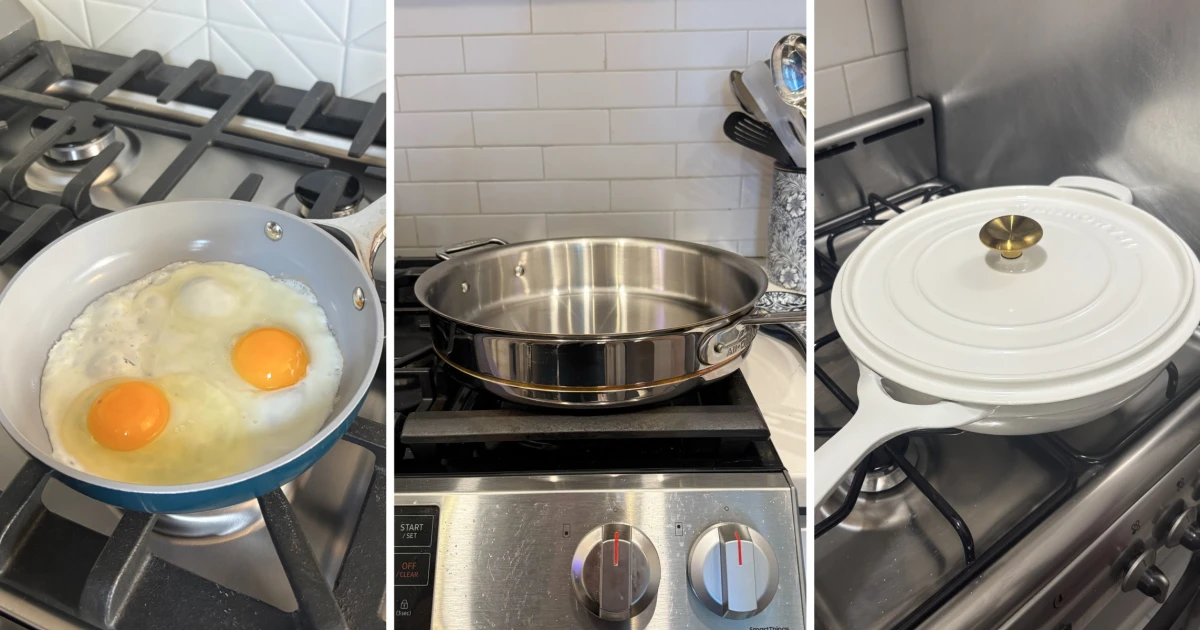
There’s no denying the convenience of nonstick cookware. Food slides around the pan while you’re making it and releases from the surface in seconds when you serve it, plus clean-up is a breeze. Despite its benefits, however, nonstick cookware often gets a bad rap. It’s usually made with forever chemicals, man-made compounds that give pots and pans their nonstick property, but can negatively impact human, animal and environmental health, according to the U.S. Environmental Protection Agency. Does that mean it’s time to ditch nonstick cookware entirely?
Below, I talked to scientists and cooking professionals about whether nonstick cookware is safe to use. Experts also share the best nonstick cookware alternatives (also sometimes called nontoxic cookware) to buy if you want to reduce your exposure to forever chemicals.
Want more from NBC Select? Sign up for our newsletter, The Selection, and shop smarter.
What are forever chemicals?
Forever chemicals, or Per- and polyfluoroalkyl substances (PFAS), are a group of man-made chemicals that are resistant to degradation due to their strong carbon-fluorine bonds — once they’re produced, they can take hundreds of years to break down, says SonBinh Nguyen, a professor of chemistry at Northwestern University. Forever chemicals were originally invented in the 1940s, and soon after, they were widely used in everyday consumer goods because they have water- and oil-resistant properties, and can even make some items stain-resistant, he says. You can find them in products like cookware, cosmetics, cleaning supplies, clothing, upholstered furniture, food packaging and personal care items. PFAS help prevent your rainboots from getting soaked when you step in puddles, your waterproof mascara from running when you cry and your omelet from getting stuck in a skillet, for example.
Why are forever chemicals in nonstick cookware?
Adding a PFAS-based coating to a pot or pan’s cooking surface makes it nonstick, as well as water- and grease-resistant, allowing food to release easily. The cooking surface essentially becomes slippery, even when you don’t spread oil or butter over it, says David Nadler, a teaching assistant professor at New York Institute of Technology.
Marc Grégoire, a French engineer, created the first nonstick pan in the early 1950s, according to T-fal, the company he founded. He coated an aluminum pan in Teflon, a brand name for a specific type of PFAS called Polytetrafluoroethylene, or PTFE. (It’s important to note that all Teflon is PTFE, but not all PTFE is Teflon. Think of it like how all Sharpies are permanent markers, but not all permanent markers are Sharpies.)
In addition to PTFE, Teflon was made with Perfluorooctanoic Acid, or PFOA, another type of PFAS, for decades. But after numerous studies established links between PFOA exposure and human, animal and environmental health risks, major companies phased it out by 2014 due to an agreement between the chemical industry and the U.S. government. (Perfluorooctanesulfonic acid, or PFOS, was phased out, too.) At that point, manufacturers switched to mainly using PTFE-based coatings in nonstick cookware. Not all of them are Teflon, which is now made without PFOA, but this brand-name PTFE is still heavily relied on.
Is it safe to use nonstick cookware?
The FDA currently authorizes certain forever chemicals for limited use in cookware. The manufacturing process ensures that negligible amounts of PFAS in nonstick cookware can migrate to food, according to the FDA. Also, the tiny concentrations of PFAS you’re exposed to through nonstick cookware is a drop in the bucket compared to other toxins you come into contact with daily from sources like vehicle emissions, cleaning supplies and pesticides, for example, says Nadler.
So can you keep your nonstick cookware? Yes, but be conscious of how you use it and when you need to replace it (read about safety tips below). However, if you want to minimize your exposure to forever chemicals through cookware, there’s plenty of nonstick alternatives out there — I broke down some of the best ones below.
How I picked the best nonstick cookware alternatives
While shopping for nonstick cookware alternatives, experts recommend thinking about the following factors, all of which I considered while curating my picks.
Material: Ceramic- and enamel-coated cookware are the closest alternatives to traditional nonstick cookware. Stainless steel, cast iron, carbon steel and 100% ceramic cookware are also options, but they’re not inherently nonstick. Over time, cast iron and carbon steel cookware can become nonstick through seasoning, which involves applying oil to the surface and heating it to create a hard, natural, non-stick coating over time. Stainless steel and 100% ceramic cookware can’t become nonstick, but if you cook with it the right way, you can prevent food from getting stuck.
PFAS-free: When brands label cookware PFOA-, PFOS- and/or PTFE-free, it means pots and pans are made without those specific PFAS. They could, however, still be made with other PFAS, of which there are thousands of, experts told me. Looking for a PFAS-free label is the best way to avoid forever chemicals in cookware, according to the experts I talked to. This mainly applies to ceramic- or enamel-coated cookware, but be aware of brands’ claims about forever chemicals regardless.
Heat resistance: Compare your cooking habits to the temperatures brands say are safe for their pots and pans. Also, think about whether being able to transfer your cookware from the stovetop to the oven is important to you. If it is, buying oven-safe cookware is a must.
Stovetop agnostic: This means you can use cookware on any type of stove, including gas, electric and induction, giving you the most flexibility.
Shape and size: Deciding what size and shape cookware is best for you depends on how many people you’re feeding and what you typically cook. Descriptions on product pages usually explain what the specific piece of cookware you’re looking at is best for.
Cleaning: Follow a brand’s care instructions exactly to properly clean and maintain your cookware. For example, some materials, like cast-iron and carbon steel, can’t go in the dishwasher, and often, brands recommend hand-washing ceramic-coated cookware so the surface retains its nonstick property.
The best nonstick cookware alternatives for your kitchen
To recommend the best nonstick cookware alternatives, I rounded up options that align with expert guidance and are NBC Select staff picks. I focused on pans like sauté, fry and griddle pans rather than pots — when people look for nonstick cookware, they typically focus on pans the most, according to experts. Most of my picks are ceramic- and enamel-coated since these types of cookware are the most similar to traditional nonstick, but there’s a few other materials on my list, too. I only included cookware from brands that explicitly state their products are PFAS-free or are uncoated.
Best ceramic-coated cookware
“Ceramic-coated cookware has nonstick properties, but without the chemical treatment,” says Alycia Johnson, vice president of merchandising at Sur La Table. (Ed’s note: The inclusion of products sold by Sur La Table in this article was made independently of Johnson.) It usually has an aluminum base and a naturally nonstick, mineral-based coating made from silica, sand or clay. Since food releases from ceramic-coated cookware so easily, it’s ideal for making delicate dishes like omelets, fish and pancakes. Cleaning it is also low-maintenance since debris slides right off with a gentle scrub.
While ceramic-coated cookware gives you a nonstick surface without the forever chemicals, it has similar drawbacks to traditional nonstick. “High heat is going to be an enemy, and often, metal cooking utensils can scratch the surface,” says Johnson. “Ceramic-coated cookware performs better at a lower temperature, and it maintains that temperature for longer. It’s more likely to scorch your food if you use high heat.”
I’ve used Caraway’s ceramic-coated cookware for years and I’m continuously impressed by its nonstick surface. I cook almost every day, so I beat my pots and pans up, but the coating still looks nearly flawless and food never gets stuck on it. I reach for the brand’s frying pan most — I have two 10.5-inch models that I sautè and steam fish and vegetables in, and one mini 8-inch model that’s my go-to egg pan. Buying the frying pans with glass lids is essential, in my opinion — I use the lids more than I thought I would. I also have a griddle pan for pancakes and French toast, and a Petite Cooker (a mini stock pot) for small batches of grains.
Best budget ceramic-coated cookware
GreenPan’s ceramic-coated cookware is less pricey than some of the other PFAS-free options on this list, but it performs just as well, says NBC Select commerce editor Cory Fernandez. “I’ve had cookware from Greenpan for over two years and it’s held up incredibly well,” he says. “Nothing sticks to it, and it doesn’t develop an unpleasant greasy film. I’ve washed it in the dishwasher tons of times and it’s still in great shape. I also love that the skillet is oven-safe so I can transfer partially cooked food to it without worrying about overcooking meat and poultry.” The pan’s base stays flat when it’s cool and flexes when it’s hot, allowing oil to stay exactly where you put it, according to the brand.
Best enamel-coated cookware
Enamel-coated cookware typically has a cast iron or stainless steel base, and its nonstick coating is created by fusing powdered glass particles to the metal surface at high temperatures. You’ll most commonly see enamel-coated cast iron pans, Dutch ovens and pots, which better distribute and retain heat compared to ceramic-coated cookware. This material also browns, braises and sears food at high temperatures, which isn’t one of ceramic-coated cookware’s strong suits. You still need to be careful about scratching the coating with metal utensils, however.
NBC Select SEO editor Nikki Brown keeps Tramontina’s enameled cast iron skillet, which comes with a lid, in her kitchen. “I wanted a cast iron skillet because it’s a workhouse that can cook an extensive range of meals, which ultimately saves space in my very small kitchen,” she says. “I thought I would need to save up to buy one since most options are expensive, but I got this very affordable one on sale and it’s getting the job done so far.” Brown makes seafood, meat and veggies in the skillet, and says it releases food pretty well considering its lower price point.
Best stainless steel cookware
Stainless steel cookware is highly durable and versatile — pots and pans can last a lifetime (as long as you care for them properly) and withstand high temperatures over the stove or in the oven. They also distribute heat evenly and are often dishwasher-safe. However, using stainless steel cookware involves a learning curve, and preventing food from sticking to it requires a little effort.
“You can get nonstick results with stainless steel, but you have to have the skills to navigate the contributing factors to that cooking experience, like the right temperature and how long to maintain that temperature,” says Johnson. “Because of that, we see the most interest in stainless steel from folks who want to expand and advance their cooking.”
NBC Select editorial projects manager Rebecca Rodriguez swears by her stainless steel cookware from All-Clad. “There’s a reason All-Clad is a household name, and my family has been using its cookware my entire life,” she says. “My dad got me a pan four years ago and my husband and I use it at least once a week. It’s great at distributing heat and evenly cooking food, even with our uneven stove. I love how deep this pan is so things aren’t splashing out of the pan when cooking with oil.” The pan is made from five layers of metal, including a copper core, which heats up quickly since it’s so responsive, according to the brand.
Best hybrid cookware
HexClad’s cookware has a part steel, part nonstick surface — it’s made with hexagonal steel ridges that help sear food, and there’s a ceramic coating inside the ridges that prevents ingredients from getting stuck while you’re cooking, according to the brand. NBC Select updates editor Mili Godio owns a HexClad pan, which she and her husband mostly use to brown meat like chicken breast, kielbasa, hamburgers and taco meat. “This frying pan has lasted me years, and it’s still in perfect shape despite being one of the only cookware items I use,” says Godio. “It’s durable and entirely nonstick, so I don’t have to worry about the annoying cleaning process.”
The pan, which you can buy with or without a glass lid, gets hot quickly thanks to its aluminum core, and it evenly distributes heat, according to the brand. The handle also stays cool even when it’s sitting over a flame, says Godio. HexClad says you can use metal utensils on its cookware despite it having a nonstick ceramic coating — Godio hasn’t noticed any scratches on the interior of her pan, although it’s dark in color, so it hides scuffs well.
Best uncoated nonstick
Our Place’s Titanium Always Pan Pro is somewhat of a unicorn in the nonstick cookware space. It’s completely nonstick, but it doesn’t have a ceramic or enamel coating, even though it’s made from traditionally “sticky” materials like stainless steel.
To prevent food from getting stuck on the pan, Our Place added a tiny, textured, dot-like pattern to its cooking surface (read more about it here). The pattern mimics the lotus effect, a naturally occurring phenomenon — it makes lotus leaves’ surface repel liquid, which beads up and easily rolls off, according to the brand. Our Place says you need a little cooking oil to activate the pan’s nonstick surface. Then, the dots sear food while the little pockets between them allow for airflow, preventing ingredients from sticking and eventually causing them to self-release.
I have the large 12.5-inch Always Pan Pro, which I use when I’m cooking for a crowd, especially during the holiday season. Food slides off the surface once it gets slightly golden brown, and the pan has impressive heat retention, too. When I fry potato pancakes or chicken schnitzel, for example, the oil’s temperature barely drops over time. I also appreciate that the pan has high sides and a deep base, so I can use it as a skillet, fry pan or mini pot. In fact, you might get away with this pan being the only cookware you own if you typically make simple, one-pan meals. The Always Pan Pro comes with a spatula and a built-in spoon rest on its handle. You can put it in the dishwasher, but it’s easy to hand-wash, in my experience.
Nonstick cookware safety tips
If you plan on keeping traditional nonstick pots and pans in your kitchen, there are a few key safety tips experts want you to know about.
Never heat nonstick cookware over 500 degrees Fahrenheit: “When we use nonstick cookware at normal temperatures, the PFAS are relatively inert, but the hotter it gets, the more that stuff can start fuming out of the pan,” says Nadler. “Then there’s potential to breathe it in, and some vapors are potentially seeping into food, so you’re ingesting them. If you’re cooking at lower temperatures, there’s still some risk potential, but it’s not as great.” Always follow manufacturer directions exactly as specified, too — experts recommend not heating nonstick cookware over 500 degrees Fahrenheit, but if the brand you buy from recommends something different, go with those directions.
Don’t use metal utensils on nonstick cookware: If nonstick cookware’s surface gets scratched or erodes away, there’s a higher likelihood that forever chemicals will transfer to your food, says Nadler. Avoid unnecessary damage by opting for wood or silicone cooking utensils instead of metal ones.
Gently hand-wash nonstick cookware: Even if a brand says its nonstick cookware is dishwasher-safe, it’s a good idea to opt for hand-washing instead. “Never scrub nonstick cookware with anything abrasive,” says Tracy Zimmermann, an assistant professor of hospitality management who teaches culinary arts at the New York City College of Technology. “Gentle cleansing with soapy water and a soft towel works best. Also, don’t stack nonstick cookware in storage unless a soft cloth is placed between pieces to prevent scratching.”
Replace nonstick cookware as needed: Once your nonstick cookware starts to show signs of wear and tear, it’s got to go. Look for scratches on the surface, and pay attention to when your cookware starts to lose its nonstick property, says Zimmermann. At that point, it’s time for a replacement. “Most nonstick pans work well until they don’t,” she says. “If they’re cared for properly, they can last many years. If not, then it’s a matter of months.”
Why are forever chemicals dangerous?
Forever chemicals are manufactured in labs across the world, and they’re used to produce numerous products. For example, fire extinguishing foam, food packaging, household essentials like cleaning supplies, paint, clothing, upholstered furniture, nonstick cookware and personal care products like makeup and floss all contain PFAS, according to the EPA. Forever chemicals can enter the environment as they’re produced, and while people make and use products that rely on them.
Because forever chemicals don’t break down easily, they build up in the environment and have plenty of time to move around throughout their lifespan, which spans generations. “They can travel long distances if they get into the air or water, and they can spread all over a region, if not globally,” says Nguyen. “Once forever chemicals contaminate water, the air and soil, humans and animals all have some exposure to these persistent toxins, which can negatively impact their health.”
Beyond being resistant to degradation, forever chemicals are oleophilic, which means they like fat, says Nguyen. Once they get into humans’ and animals’ bodies, these substances absorb into internal structures like fatty tissues, and as they bioaccumulate (build up over time) they’re nearly impossible to get rid of. According to the CDC, being exposed to high levels of PFAS can lead to decreased fertility, developmental risks and delays in children, increased risk of some cancers, decreased immunoresponse and more.
Is nonstick cookware banned in some states?
Over the past few years, some states have completely banned, or are currently working to ban, the sale of nonstick cookware, as well as other products like floss and cleaning supplies, made with PFAS. For example, under Amara’s Law in Minnesota, products that contain intentionally added PFAS, including cookware, are prohibited from being sold as of Jan. 1, 2025. Connecticut, Maine, Vermont and Rhode Island passed similar laws, which go into effect in 2028, 2026, 2026, 2027, respectively.
Additionally, California’s state legislature recently approved Senate Bill 682 to prohibit the sale of cookware, as well as other products, that contain PFAS. California’s governor has until Oct. 12 to sign the bill into law, and if he does, cookware manufacturers and retailers must comply by 2030. Other states, like New York, have introduced similar bills, but many haven’t been voted on yet.
Meet our experts
At NBC Select, we work with experts who have specialized knowledge and authority based on relevant training and/or experience. We also ensure that all expert advice and recommendations are made independently and with no undisclosed financial conflicts of interest.
SonBinh Nguyen is a professor of chemistry at Northwestern University.
David Nadler is a teaching assistant professor in the department of bioengineering at the New York Institute of Technology.
Alycia Johnson is the vice president of merchandising at Sur La Table. (Ed’s note: The inclusion of products sold by Sur La Table in this article was made independently of Johnson.)
Tracy Zimmermann, an assistant professor of hospitality management who teaches culinary arts at the New York City College of Technology.
Why trust NBC Select?
I’m a reporter at NBC Select who has written about kitchen products for five years, including plastic cutting board alternatives, meal prep containers, dinnerware sets, and air fryers. To write this article, I spoke to four experts about nonstick cookware alternatives and forever chemicals. Using their guidance, I rounded up the best nonstick cookware alternatives, all of which are NBC Select staff picks.



